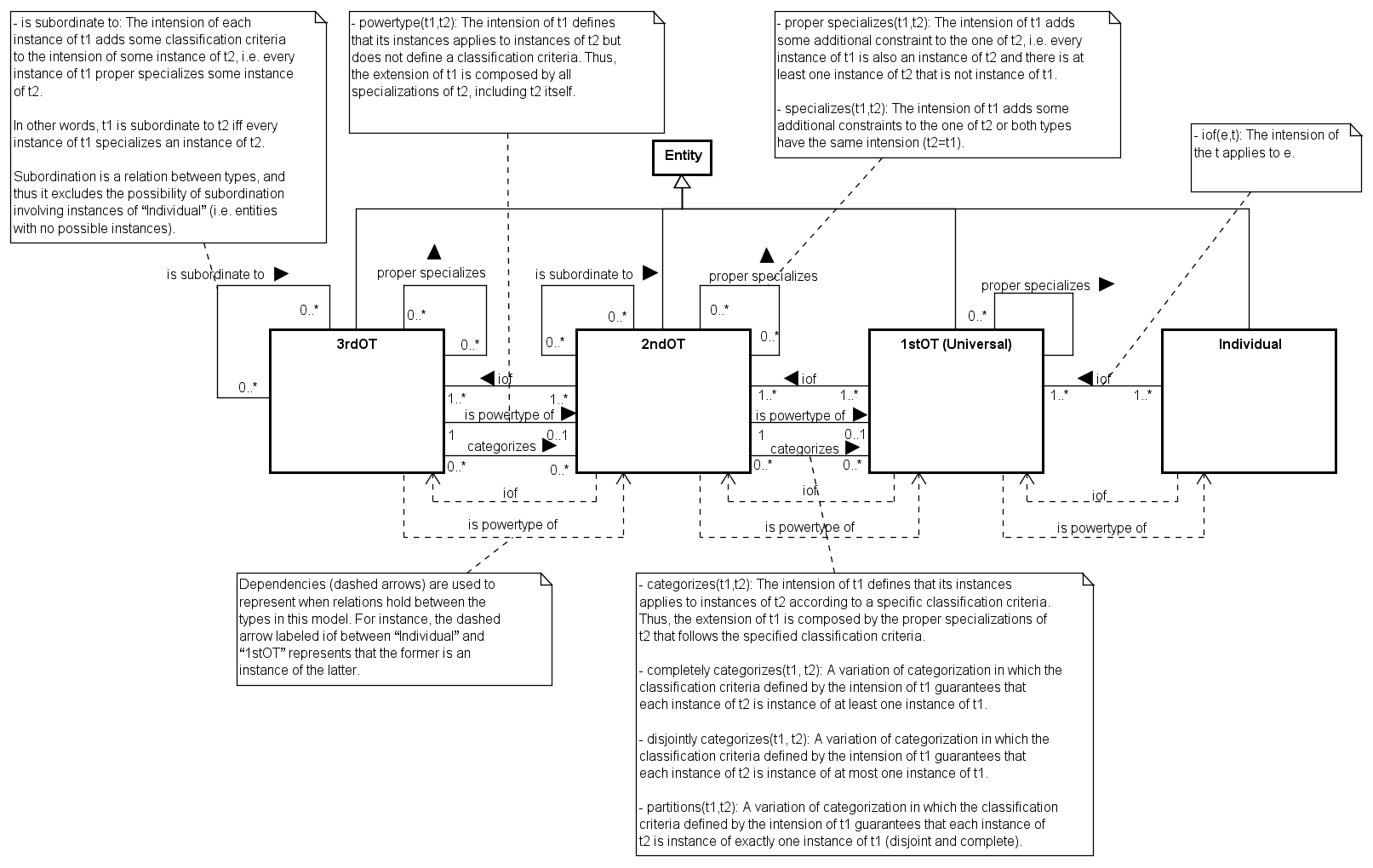Multi-Level Theory
- similar: Class as Values Metagraph
Implementations
- ML2, Melanie, Deeptelos, OntoUML, Incorporating Types of Types in Ontology Driven Conceptual Modeling
UFO

chatgpt4.o
(with a few prompts to fix things up)
Multi-Level Theory (MLT) Summary with Corrected Examples
Multi-Level Theory (MLT) is a framework used in modeling and ontology to represent entities across multiple levels of abstraction. Unlike traditional class hierarchies where entities are related by subclass relationships, MLT focuses on meta-class relationships, where each level defines a higher-order structure or type for the level below it.
Levels of MLT:
-
M3 Level (Meta-Meta-Level): "Types"
- Description: This is the most abstract level, representing the concept of types or classes themselves. It defines the meta-structure for how types are organized and classified.
- Example: "Types" define what it means to be a type or class in any domain. It provides the foundational concept from which other types (meta-classes) are derived.
-
M2 Level (Meta-Level): "OrganizationalUnitType"
- Description: At this level, you have the meta-class that defines the general concept of organizational units. This meta-class provides the template for various kinds of organizational units, such as departments, teams, or divisions.
- Example: "OrganizationalUnitType" is a meta-class that describes general properties and behaviors of organizational units across different contexts. It serves as a blueprint for more specific classes like "Department Class."
-
M1 Level (Type Level): "Department Class"
- Description: This level represents a specific type within the broader concept of OrganizationalUnitType. "Department Class" is a type that can have different kinds of departments as its subclasses, such as HR Department, Finance Department, etc.
- Example: "Department Class" is a class within the "OrganizationalUnitType." It specifies what it means to be a department and can be further specialized into subclasses like "HR Department" or "Finance Department."
-
M0 Level (Instance Level): "HR Department of Company X"
- Description: This is the instance level where specific, real-world examples exist. Instances are actual entities that are instantiated from the classes defined at the M1 level.
- Example: "HR Department of Company X" is an actual, specific department within a particular organization. It is an instance of the "HR Department" subclass, which itself is part of the "Department Class."
Example in Practice:
-
M3: Types
- Defines the fundamental concept of a "type" or "class."
-
M2: OrganizationalUnitType
- Specifies meta-classes for organizational units, like "Department Class."
-
M1: Department Class
- Describes specific types of departments, with potential subclasses like "HR Department."
-
M0: HR Department of Company X
- A concrete instance of a department in the real world, such as the HR department in a specific company.
Key Points:
- Meta-Class Relationships: Each level is related to the one above it through meta-classification, not subclassing. For example, "OrganizationalUnitType" at M2 defines what "Department Class" at M1 can be, and "Department Class" at M1 defines what the instances at M0 can be.
- Instantiation: Entities at a lower level instantiate or realize the types defined at the higher levels, with M0 entities being real-world examples of the M1 types.
- Abstraction: Higher levels are more abstract, defining broader concepts that provide structure and constraints to the more specific types and instances at lower levels.
This structured approach allows for the modeling of complex systems where entities exist at multiple levels of abstraction, providing a clear and organized way to represent and relate these entities across different levels.
Relationship to Metagraphs
multi-level theory relates to metagraph constructs, as both deal with:
- Recursivity: Entities can be both instances and types
- Higher-order relationships: Types of types, properties of properties
- Emergence: Complex entities with dual nature (like metagraph vertices that can contain other graphs)
References
- Multi Level Conceptual Modeling Theory Language and Application
- Melanie Multi Level Modeling and Ontology Engineering Environment
- Deep Telos and Dmla a Contribution to the Multi 2022 Collaborative Comparison Challenge
- An Extensible Approach to Multi Level Ontology Modelling
- Multi-Level Ontology-Based Conceptual Modeling
- Extending the Foundations of Ontology Based Conceptual Modeling with a Multi Level Theory
- Foundations for Multi Level Ontology Based Conceptual Modeling
Backlinks
- An Extensible Approach to Multi Level Ontology Modelling
- Extending the Foundations of Ontology Based Conceptual Modeling with a Multi Level Theory
- Incorporating Types of Types in Ontology Driven Conceptual Modeling
- Multi Level Conceptual Modeling Theory Language and Application
- Representing Classes as Property Values on the Semantic Web
- Instances Are Sometimes Classes
- Unified Foundational Ontology
- 2024-09-27: Let’s Reboot the Semantic Web with Alternate Realities
- gUFO
- Philosophy of Creation